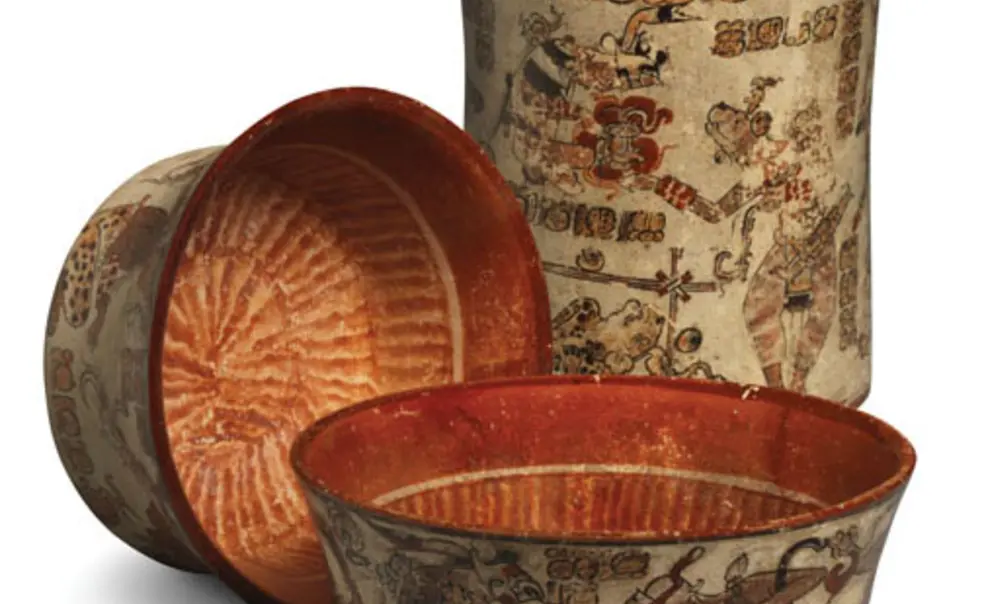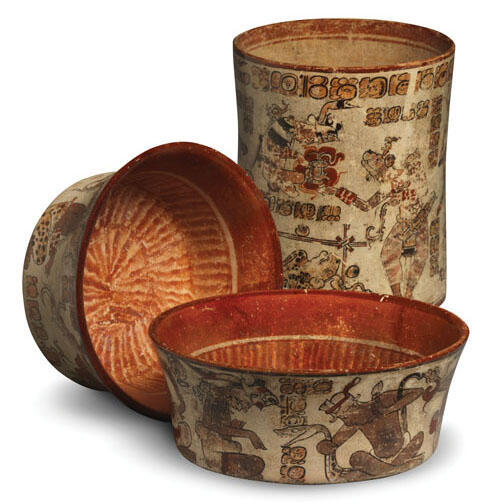Art museum exhibit seeks to balance provenance, scholarship issues
As awareness of the murky history of art objects has grown in recent years, the museum world has struggled with whether items that lack complete documentation should be displayed, even when they have great artistic and educational value. That’s a question the Princeton University Art Museum has grappled with in mounting a new exhibition of Maya vases.
The exhibition, “Dancing Into Dreams: Maya Vase Painting of the Ik’ Kingdom,” runs through Feb. 17, bringing together 18 vases — 14 of them borrowed — from the eighth-century Ik’ kingdom in present-day Guatemala.
As the catalog states, painted ceramics of the kingdom represent “an extraordinary and sophisticated history of artistic achievement, involving several features otherwise unattested in the ancient (pre-European contact) America.” There is much to be learned from them.
However, scholars generally believe that nearly all the Maya vases from the Ik’ kingdom in museums and private collections today were not excavated scientifically, said exhibit curator Bryan Just, and little is known of their origins.
The catalog notes that it is a matter of debate whether exhibiting ancient Maya works of art contributes to increasing the value of such objects “and by extension, to promot[ing] additional uncontrolled digging.” But Just said he does not believe that “by exhibiting work collected by other museums and private collectors we are ... increasing demand or encouraging present-day unprofessional excavation” of Maya objects.
“To outrightly ignore unprovenienced but authentic antiquities — the approach of some students of ancient Maya art — is to choose a moral high ground that effectively contributes to the obfuscation of portions of the past we seek to understand,” Just wrote in the catalog. “By contrast, I consider the inclusion of all known works of ancient art, regardless of provenance, a basic responsibility of academic and curatorial discourse, but with the proviso that the recent histories of such works, however contentious, be made transparently available.”
In mounting the exhibition, the art museum developed a new policy for borrowing objects. Like most museums in the United States, the museum had no stated provenance policy for incoming loans, but generally followed the practice of requiring borrowed items for exhibitions to have a documented history of ownership back at least to 1970 — matching the requirement for its acquisitions policy, which was established in 2007. The new borrowing policy allows the museum to adapt the date of required provenance on an exhibition-by-exhibition basis, depending on the prevailing laws and bilateral agreements in place, while requiring that full provenance information be disclosed publicly, explained museum director James Steward.
In the case of this exhibition, the policy permitted the museum to borrow and display Maya items with documented provenance prior to April 1991, as long as they are not known to have been stolen and their ownership is not contested. (April 1991 is the date of an agreement between the United States and Guatemala on the importation of antiquities.)
The vases in the exhibit are drinking cups used by eighth-century nobility. They depict scenes from court activities — including dancing ceremonies, rituals, and courtly games — and creatures that suggest sickness. Ten of the vases are signed by the painter or can be attributed to a specific artist. The sophisticated painting style indicates that there was a thriving community of artists in the Ik’ kingdom, Just said.
“We should preserve these things as best we can — whatever path brought them to our attention,” the curator said. “We would have a very narrow understanding of this [Maya] civilization today if we didn’t incorporate this material in study.”
He said the exhibition presents a “tragic, unfortunate tale” of practices “that have irrevocably limited our ability to study and appreciate the past,” including unprofessional excavation, damaging or misleading restoration efforts, and “the censure of academic study and public access to antiquities” whose provenance is not completely documented.
Steward described the new borrowing policy as a “middle position” that allows the museum to advance scholarship and yet do so in a “morally and ethically rigorous way.” He said he hopes it will become “a mechanism for bringing interesting objects to the light of day.”













1 Response
Fred Fraley ’54
9 Years AgoRecalling the Oppenheims of Princeton
Your article on the provenance of artistic items in the Princeton University Art Museum (Campus Notebook, Oct. 10) raises the issue of the outcome of the Monet and Gauguin paintings and other art objects of the collection of Gabrielle and Paul Oppenheim of Princeton. I viewed them in the art museum in the late 1980s and 1990s. The paintings were displayed as loans from an anonymous lender. I knew the Oppenheims as a speech-therapy student of Gabrielle from 1950 to 1954 and as her longtime friend.
The Oppenheims were of the highest level of European Jewry before World War I. Gabrielle’s father was Rector of the University of Brussels. Her mother was Italian. Paul was a German-Jewish executive in IG Farben, the German armaments manufacturer. They were part of a social set that included Albert Einstein. These people bought and collected modern art at Left-Bank Paris prices in the early 20th century.
Hitler’s assumption of power in 1933 caused Paul’s immediate ouster from IG Farben. Miraculously, they and their two sons got out of Germany with all of their modern art. They followed their friend Einstein to Princeton, and famously walked every Sunday morning with Einstein along the Lake Carnegie pathway. They lived in a colonial-revival house at 57 Princeton Ave., which had a soft contemporary decor to display their paintings. The color scheme of pink and light blue was keyed to a Monet painting of London Bridge over their living room mantel.
Gabrielle was about 55 when I met her. Beyond speech therapy, we became cultural friends. Our speech therapy concentrated on slow reading of D.H. Lawrence stories – not bad duty. She would take me to New York to visit the art museums and galleries, especially the Frick and MOMA. We’d have lunch at the old Russian Tea Room. I see the experience now as a mentorship within a Princeton education – all for five bucks per therapy session. Paul died first, followed by Gabrielle at more than 100.
At my 35th reunion with my wife, Anne, and daughter, Mary, we visited Gabrielle. She must have been 94 years of age. She made a tragic confession that explained our close friendship. Her younger son had died in the terrible Coconut Grove nightclub fire in the 1940s. It was as if he had died in a German concentration-camp oven. In her grief I became a substitute son, for which I was very grateful.
Did Gabrielle help me with my stuttering? Her relaxation technique was not what I needed. I was 56 when my father died. I came to terms with his unreasonable pressure on me throughout my life. None of my achievements was ever high enough for him, especially in my adulthood. He was sending me want ads for general-counsel positions into my 50s. He probably expressed dissatisfaction with my early childhood speech, causing the onset of stuttering. At his death, I accepted myself as a stutterer and adopted the best techniques of my experience. I speak fluently, with only the involuntary repetitions inherited from my childhood. Like many parents, my father was paying for therapy to correct the problem of stuttering that he had caused. In many ways, I always had a secret life from him. My pleasure of knowing Gabrielle Oppenheim was one of them.